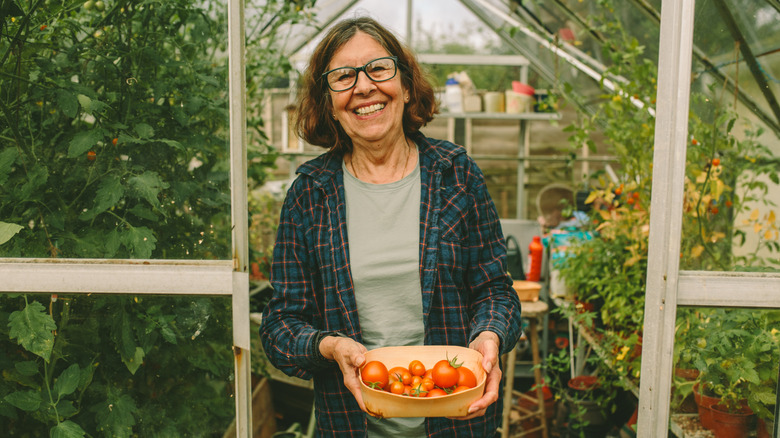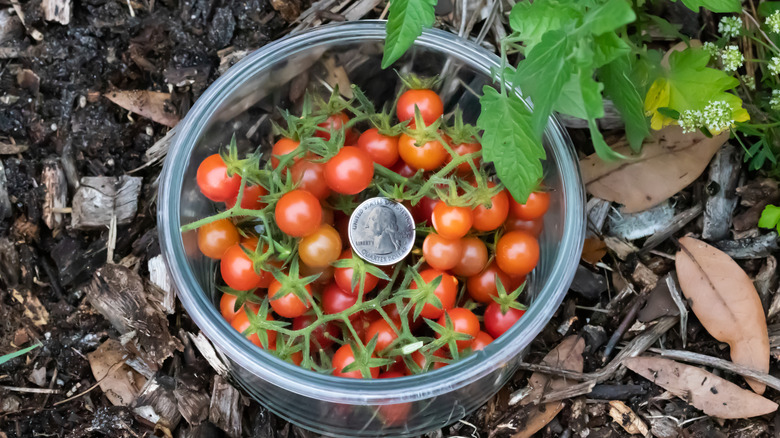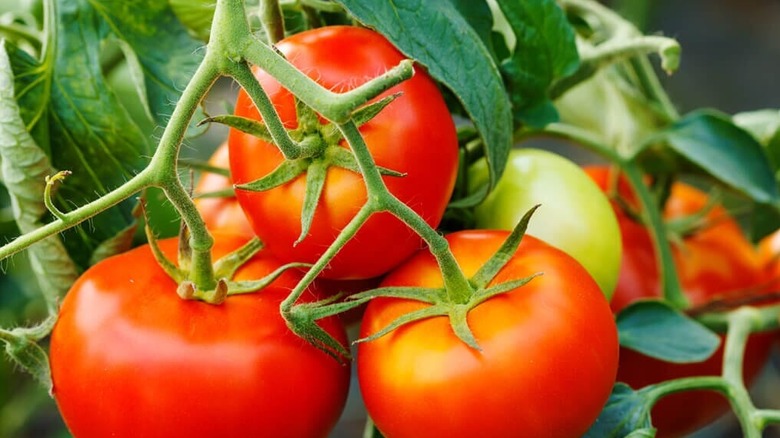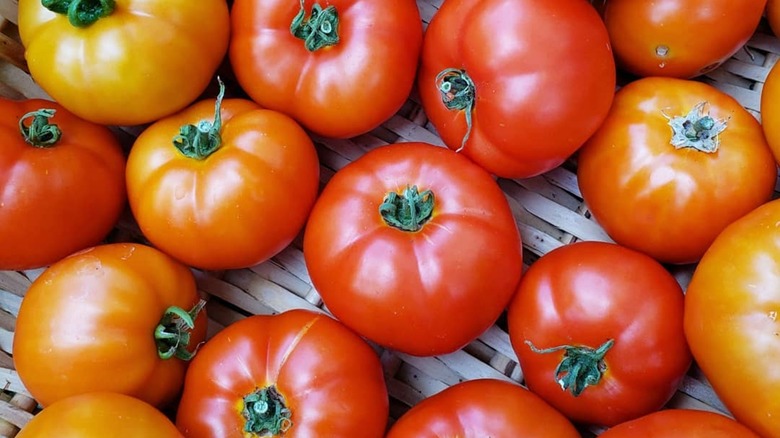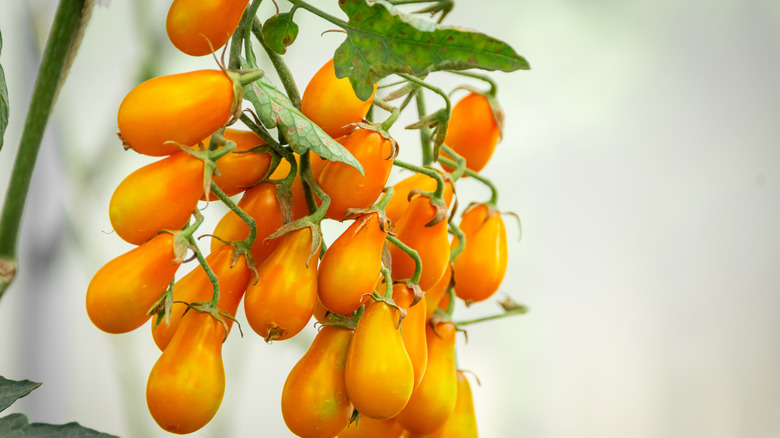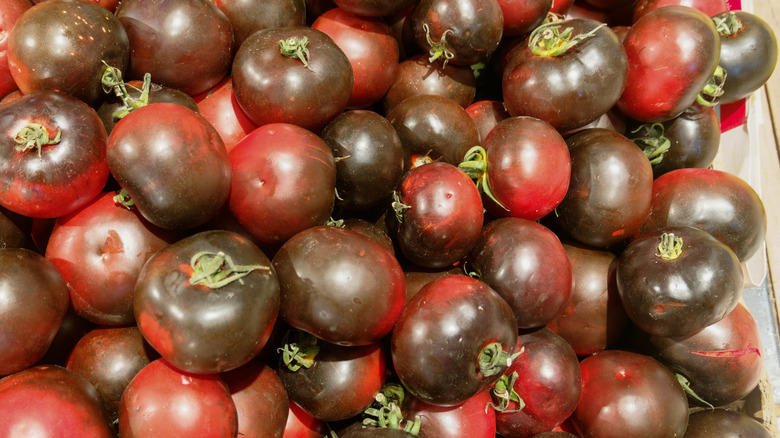The Best Heat-Tolerant Tomato Varieties You Can Grow In Florida
The intense heat Florida is famous for isn't always kind to tomatoes (Solanum lycopersicum). As much as the hot, damp conditions can be a big help for growing tropical fruit like papayas and bananas, tomato growing in Florida intimidates many gardeners, whether they're new to the area or not. The climate can hit tomato plants with heat stress that diminishes the yield of the crop. Many tomato plants stop producing fruit when daytime temperatures soar above 95 degrees Fahrenheit, or if they do, the fruit they produce won't develop the deep red color iconic to tomatoes. Thankfully, there are tomato varieties like 'Everglades,' 'Neptune,' and 'Yellow Pear' that can stand up to the high temperatures of a Florida summer. As an added benefit, some of these varieties are also resistant to the common pests and diseases that can overtake tomatoes in the humid conditions.
Don't let Florida's mild winter weather fool you — you should still wait to plant tomatoes outside until after the risk of frost is behind you. The exact time to plant tomatoes depends on your location in Florida, but should be before nighttime temperatures rise above 80 degrees Fahrenheit. To make sure you're growing the best tomatoes given the climate conditions, add organic matter to the soil to counteract its natural sandiness and plant your tomatoes near an easily accessible water source, making sure to give them an inch or two of water every week.
Everglades
If you're okay with tomatoes that are tiny but still bursting with flavor, try growing the Everglades tomato (Solanum pimpinellifolium). This wild species of tomato is resistant to drought. Its tomatoes are about a half inch in diameter, but unlike some of its relatives, this plant can keep bearing fruit as the hot summer days continue. This resilience makes it a great choice if you're gardening in southern Florida. Everglades tomato plants can even re-seed on their own so that the crop keeps coming back year after year. Give them plenty of sunlight and well-draining soil, and watch the plant burst out cluster after cluster of six to 10 bite-sized tomatoes.
Everglades tomatoes are vining types, also known as indeterminate. What's the difference between determinate and indeterminate tomatoes? Indeterminate varieties, like the Everglades tomato, grow their fruits on long vines that can keep growing unless they're pruned, while determinate types grow to a particular size and then stop. Since their vines sprawl out and the plant can reach 12 feet in all directions, give them plenty of space in your vegetable garden or let them grow up a trellis for support. Another tip is to harvest the tomatoes carefully, as their skin is prone to tearing.
Florida 91
Even though most of the larger tomatoes known as 'slicers' don't always grow well in Florida, the Florida 91 (Solanum lycopersicum 'Florida 91') seems to be an exception. The plant produces highly flavorful 10-ounce red tomatoes as it stands up to high temperatures. While other cultivars of the tomato plant have trouble setting fruit in the heat, the Florida 91 can grow tomatoes in hot and humid conditions. Unlike more sprawling varieties, these plants grow in a bushy form usually not taller than 3 feet, and their tomatoes will be ripe for the picking within the same two- to three-week span.
They're not just resistant to the dangers of heat; Florida 91 tomato plants have also been cultivated to resist cracking in Florida's heavy rains or succumbing to fusarium wilt and verticillium wilt, which are common afflictions Florida tomatoes suffer from. It's still important to watch out for fungal blight that develops in humid conditions, though. Adding a layer of mulch around the tomato plants can guard them from spores, making it a simple garden addition to keep tomato plants blight-free.
Neptune
The Neptune tomato plant (Solanum lycopersicum 'Neptune') was developed in Florida with special attention to the conditions that make it difficult to grow tomatoes in the state and region. Thanks to its breeding, it tolerates both high temperatures and drought. It's also been cultivated to avoid developing certain types of wilt caused by bacteria which are unfortunately prevalent in the southern United States. When the tomatoes are ripe, they'll be firm on the outside and juicy within.
If you choose to grow Neptune tomatoes in containers, make sure you choose a large size. This will give you enough room to bury their stems under the soil up to the lower leaves, which gardeners recommend as a proven planting technique for healthier tomato plants. Once your Neptune tomatoes are ready to produce, you should start seeing two to four 4-ounce tomatoes per cluster at the beginning of the growing season or toward mid-season.
Yellow Pear
For something different, try a type of cherry tomato that gives you a lighter, but rich color. The Yellow Pear (Lycopersicon lycopersicum 'Yellow Pear') is an heirloom variety that's resistant to high temperatures and will keep producing over the hottest summer days. Like other varieties of cherry tomato plants, it has a longer growing window than beefsteak or slicer types, making it friendlier to Floridian temperature variations. When the tomatoes emerge and ripen, they have a tangy, sweet taste.
This plant will continuously put out long vines and its characteristic small, pear-shaped tomatoes until there is a frost, so it benefits from being grown on a trellis. It's known to get as tall as 8 feet. If you're new to growing indeterminate tomatoes, which spread out on vines, you can make simple DIY tomato supports with just wood before investing in more complicated trellises. When growing multiple plants, make sure they have around 3 feet of space between them. Whether they're in containers or in the ground, place your Yellow Pear tomato plants in full sun.
Cherokee Purple
The Cherokee Purple tomato (Solanum lycopersicum 'Cherokee Purple') is an easy-growing, large kind of heirloom tomato that's well-suited to growing in a south Florida garden. It's a good heat-tolerant option for those who want to branch out from the standard varieties. Planting this type of tomato will add variety to your garden not only because of the fruit's unique hues of purplish red, black, and green, but its earthy, smoky flavor as well.
As this indeterminate tomato plant spreads its vines, check for fruits that are big, with a bit of a flattened shape — you likely won't be able to miss them! When fully grown, they should be 10 to 12 ounces. They should be watered evenly and on a regular basis to prevent rot and cracking fruit. Although tomatoes tend to wilt during the day in the heat, the best way to determine whether they need water is by feeling the top two to three inches of the soil, even checking a few times a day in the sweltering summer. Like other larger tomatoes, it needs to bask in six to eight hours of sunlight, which shouldn't be hard to provide in sunny Florida.
